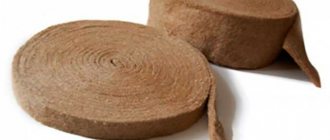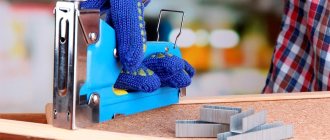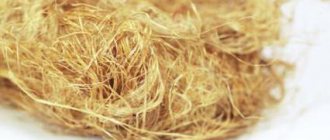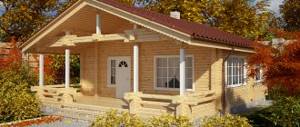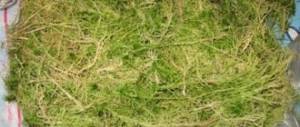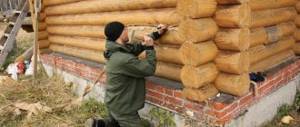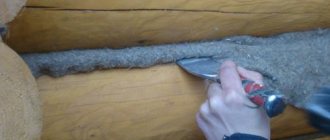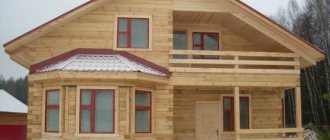Insulation of a bathhouse between the crowns refers to external thermal insulation, internal insulation of a bathhouse: floor, walls, ceiling, attic floor (if there is one) and roof - a separate article is devoted. And this is very important for a log bathhouse, since such bathhouses, as a rule, are not insulated from the inside.
The choice of material is quite difficult: there are a huge number of different products of both natural and artificial origin.
Therefore, in search of an answer to the question: “which inter-crown insulation is better for a bathhouse?” many spend a lot of time and effort.
Interventional insulation for a bathhouse: which one to choose?
As already mentioned, all insulation materials can be divided into two large groups:
- Thermal insulation based on natural materials;
- Synthetic insulating materials.
Natural
In general, we can say that natural materials have the undoubted advantage of being environmentally friendly, but at the same time they are very labor-intensive to install and are more susceptible to rot and parasites. They have also long been used for insulating baths and other buildings. The price of these materials is also attractive. Synthetic insulation is more versatile and easier to use.
Insulation materials made from natural plant fibers include:
- jute (including jute tow and jute felt);
- linen;
- combined options : flax wool and flax jute;
- moss (as the most traditional insulation for a log bathhouse).
Reference. Natural insulation also includes clay and its mixtures, which are often used for thermal insulation of ceilings, not roofs.
Jute
It is a very popular material that is produced in small rolls of tape. Its thickness ranges from 5 to 15 mm. It is characterized by high density and uniformity. This is especially evident after complete installation: the jute adheres even more, becoming resistant to moisture and wind. It is quite easy to install; you need to roll out the roll to the desired length and secure it (for example, with a construction stapler).
The disadvantages include sometimes the excessive coarseness of the fibers and low fracture resistance.
Linen
Linen is inferior to jute in ease of use, but is also in demand. It is believed that due to its ability to accept and release moisture, it allows the structure to “breathe”. It is softer and easier to take the required shape.
It is a hypoallergenic substance and has disinfectant properties.
By the way , the ability to pass water is a certain disadvantage of flax: from the point of view of moisture and wind protection, it is not very reliable. In addition, flax is susceptible to destruction by moths and other insects.
Combined options: flax wool and flax jute
When choosing combined materials, focus on the ratio of the amount of jute and flax in them. Depending on this, the material will have to a greater extent one or another of the above-described pros and cons. But, of course, combined materials can be called a good choice, since they will be more versatile and remain affordable for any budget.
Useful video
Look at the difference between jute and linen, according to an expert:
Moss (red moss, sphagnum, cuckoo flax)
It is a very common and traditional material that you can prepare yourself or purchase at a bargain price. It has bactericidal properties, but has a large number of disadvantages.
Negative features include:
- predisposition to drying out and spontaneous loss;
- the complexity of the caulking process;
- susceptible to destruction by insects and being pulled out by birds.
Based on sheep wool
A separate category is heat-insulating material based on sheep wool. Most often used in the construction of baths from profiled timber. It plays the role of insulation, moisture and wind protection. This is possible due to the ability of wool, like wood, to regulate humidity.
Another undoubted advantage is its durability: over time it does not lose its original volume.
Its disadvantages include high cost and the potential danger that moths may appear in such insulation.
Synthetic
Synthetic insulation materials include:
- thermal insulation tapes;
- combined materials.
The last two types appeared on the Russian market relatively recently. Tape material is attractive because it saves time on installation. This in turn significantly reduces the time required to build a bathhouse. Simultaneously with insulation, the tapes are able to remove moisture and play the role of wind protection. They are safe and hypoallergenic.
They are presented in a wide range depending on the parameters:
- – density (from 300 to 800 g per sq. m);
- – width (from 100 to 200 mm);
- – quantity (rolls from 10 to 50 lm).
Attention ! The question of their safety when exposed to high temperatures has not been fully studied.
Types of interventional insulation
The modern construction market offers a large selection of natural insulation materials.
The most common options are felt, jute, moss, linen and combined.
Manufacturers also offer wear-resistant synthetic insulating materials - penofol, mineral wool, polystyrene foam boards, silicone sealants.
Without a doubt, they have higher performance characteristics in comparison with natural analogues, but they are not suitable for insulating wooden buildings.
Felt (sheep's wool)
A natural material for insulation, which in its performance properties is superior to tape insulation made from plant fibers.
Felt is a worthy option for buildings made of profiled timber. It is simply irreplaceable for insulating residential buildings and baths, although it is not cheap.
During the production process, the felt seal is carefully treated with special fire-retardant compounds, as a result of which it absorbs moisture well and quickly releases it when heated.
It is resistant to mold and mildew and does not cake during use.
Felt is suitable for insulating walls and partitions of log houses and bathhouses.
Jute
Jute material is a modern representative of tape insulation, which has a dense and uniform structure. Jute is an expensive material, unlike flax, but it is of higher quality.
A distinctive characteristic of jute is its high hygroscopicity.
Jute inter-crown insulation is made from annual tropical plants of the mallow family, which grow in hot countries. Plants contain about 25% lingin - a natural resin that has high antiseptic properties.
Jute has a lot of advantages that set it apart from its main competitors:
- Environmental friendliness and safety;
- Good thermal conductivity;
- Resistance to rotting and fungal attack;
- Durability and practicality;
- Easy installation;
- Attractive appearance.
Disadvantages include susceptibility to caking and high cost.
Walls insulated with jute tape do not require additional decorative finishing, and the seams are smooth and tight.
Jute is represented by the following varieties: jute tow, jute felt and jute flax.
- Tow has solid and long fibers. Used for caulking seams.
- Felt is characterized by increased fragility and stiffness of the fibers. Used to seal door and window openings.
- Jute flax is a mixture of flax and jute fibers. It is characterized by high wear resistance and elasticity. Suitable for caulking walls and partitions.
Moss
Currently, moss remains an accessible and cheap option for insulating crowns in houses and bathhouses made of logs or timber. Moss is a natural thermal insulation material that has unique performance characteristics:
- Environmentally friendly;
- Vapor tightness;
- Resistant to creasing and deformation;
- Antiseptic properties.
Moss quickly absorbs excess moisture and provides good air exchange. It is recommended to use sphagnum (white moss) and cuckoo flax (red moss) as inter-crown insulation.
The most durable and wear-resistant is red moss, which is characterized by a high content of antiseptic components and resistance to high moisture.
White moss has high thermal insulation properties and reliably protects wood from fungal infections.
Despite the obvious advantages, moss also has some disadvantages - low fire resistance and difficulty in installation.
Linen
Linen materials for insulation have been used for quite a long time. Linen is hypoallergenic, provides good air exchange, does not create static charges, and is resistant to mold on the walls. Interventional insulation of this type has:
- High elasticity and softness of fibers;
- Long service life;
- Low thermal conductivity coefficient;
- Resistant to UV radiation, microorganisms and mold;
- Affordable price.
Currently, manufacturers offer two types of linen insulation - tow and flax wool.
Tow
It is characterized by low cost and complexity of installation. Inter-crown insulation for timber is highly hygroscopic and prone to rotting, so it is more advisable to use it to seal window and door openings.
When using tow, caulking is carried out twice - in the first year after construction is completed, and in the second year - after the building has settled.
Lnovatin
A material that is made from flax fibers using special equipment.
To give strength, the finished fabric is stitched with threads. Linen batting is affordable and easy to install. This is a good economical option that is suitable for insulating houses and baths.
Often used after complete shrinkage of the structure.
Combined insulation materials
This category includes natural-based insulation without the use of synthetic fibers.
They have unique performance properties of the material from which they are made.
Flax in combined materials increases elasticity and practicality, jute increases resistance to creasing and caking.
The special structure of combined insulation materials satisfies the needs of the building material, taking into account the climatic conditions in which it is used.
Insulation for a log bathhouse or for timber
For a log, a thicker layer of insulation (especially strip material) is taken, and for a bathhouse made of timber, a thickness of 8-10 mm is sufficient. If you use laminated veneer lumber, you can get by with a thickness of 5 mm. IMPORTANT! If there are gaps or other irregularities in the timber, the insulation is placed in two layers.
Materials based on plant fibers are perfect for logs, and roll products are ideal for timber.
It is advisable to complete the insulation of a bathhouse made of timber with finishing materials: clapboard, siding or block house. We recommend treating wooden finishing materials with special impregnations or oils.
It should be remembered that depending on the material from which the bathhouse is built, there are nuances of thermal insulation and recommendations regarding the materials used: insulation of walls made of wood, brick, blocks (especially foam concrete), frame walls requires special attention.
Useful video
Look at another professional’s opinion on the issue of “moss or jute”:
Advantages of jute insulation
Among all inter-crown heat insulators, jute has a number of advantages that are unique to it. Let's look at them:
- Bonding ability
. Jute contains lingin in large quantities. It is a natural resin that prevents rot and mold. In addition, it is capable of gluing fibers and timber together, making the seam airtight. - High rigidity
. This quality is responsible for the fact that jute practically does not wrinkle over time, which means it does not lose its thermal insulation characteristics. - Highly environmentally friendly
. Good quality material contains exclusively natural components, so jute cannot emit any toxic volatile compounds during operation. - Easy to install
. To lay jute in the inter-crown space, you do not need any special tools. All work can be done independently. The material does not emit dust and does not irritate the skin and mucous membranes. - Good vapor permeability
. This quality guarantees that an optimal climate will be maintained inside the building. - Versatility
. Felt jute, thanks to its good compressive resistance, can be used to insulate not only seams in wooden houses, but also floors, walls, and roofs. - Aesthetics
. The material has a golden natural color that matches perfectly with the color of natural timber or logs. Therefore, no additional decorative processing of jute is required.
Plant fibers or tape material
Plant fibers are often more affordable in terms of cost, but they require more installation time.
Plant fibers are more environmentally friendly, but have a shorter service life compared to synthetic materials.
Reference. A separate article is devoted to foil materials used as insulation for ceilings and walls.
Disadvantages of jute insulation
The main disadvantages of this thermal insulation material include the following:
- Relative fragility
. Since jute is a completely natural material, its service life is short. And if wood can be coated with protective compounds, then the insulation will have to be changed from time to time. - Reduced thermal insulation qualities when wet
. Although jute is difficult to wet, if it absorbs moisture, its thermal conductivity increases sharply. It takes a very long time to dry. For the same reason, it cannot be installed in wet weather. - The need for caulking
. To prevent cold air from blowing through and entering the room, the building must be additionally caulked.
Let's summarize: which interventional insulation is better for a bathhouse?
As you can see, the question about inter-crown insulation for a bathhouse, which one to choose, requires a personal decision. We've given you food for thought. The choice of interventional insulation for a bath should be based on individual needs, as well as preferences and real possibilities (financial and time).
Find out more about the choice of materials for building a bathhouse, about insulation and insulation:
- Choosing insulation for a steam room: both warm and environmentally friendly
- Basalt insulation for a bath or natural? What insulation for a bath is better? Review of the most popular
Moss as insulation
Moss log house insulation
Moss has been used as insulation for hundreds of years, and throughout this time there was practically no alternative to it, and there was no need to look for a replacement for it, because even today, moss is still widely used in this capacity. This material is of 100% natural origin and is endowed with a lot of positive properties: it is environmentally friendly, contains useful substances that have a positive effect on the microclimate in the house; “breathes” perfectly, creating in the room an atmosphere of fresh space filled with forest aroma; It retains heat perfectly, thanks to the air layers created in the inter-crown layer, and helps dry out damp wood. In addition, moss contains natural antiseptics that prevent the proliferation of unwanted microorganisms and mold.
New generation insulation materials
New generation insulation materials are called thermojute and thermolen. These are all the same natural materials with special impregnation. Low-melting biocomponents are used as impregnation. Despite the improved performance characteristics, both materials are based on jute and flax. This means that most of the shortcomings of flax are preserved in the thermal mill. Thermojute does have improved characteristics, but the price of the material is significantly increased.
Another new generation material is polyester insulation - holofiber. Holofiber is a springy material that is not susceptible to rotting, mold or pests. Calmly withstands moisture, mechanical stress and sub-zero temperatures. At the same time, due to its elasticity, the material fills the gaps between the logs well. The use of this material is especially important when building a house from logs without grooves.
An interesting new product - insulated timber
Know-how in wood construction - laminated veneer lumber with insulation inside - is gaining popularity by leaps and bounds.
This material is made according to the sandwich panel principle:
- Along the edges there are lamellas made of wood;
- Inside there is insulation: polyurethane foam, ecowool or cellulose.
Ask construction stores about the availability of such materials; if they are in stock, ask for advice on this product.
In the photo - modern insulated timber
What you should not use to insulate a log house.
Insulation with polyurethane foam, mineral wool.
Foaming the cracks of a log house is not the best idea, because... Polyurethane foam does not have sufficient elasticity; when exposed to sunlight, it dries out and falls apart. It’s also not worth laying mineral wool between logs - mineral wool wrinkles under the weight of the logs and shrinks. In addition, soft wool is gyroscopic - it absorbs water from the environment, as a result of which the seam between the logs may freeze through. Due to increased humidity, wood begins to rot. It will be possible to insulate the wall of a wooden house or bathhouse with cotton wool, but not the space between the crowns.
Insulation of log walls
If it is necessary to decorate a wooden house, its thermal insulation can be strengthened at the same time.
As a facing material, you can use the same natural, and therefore completely environmentally friendly:
- Board-lining;
- Block house;
- Imitation of valuable wood species (panel, plank);
- Wood siding, etc.
How, for example, is fastening a blockhouse to a timber wall using insulation:
- First, a wooden frame made of bars is fixed to the wall;
It is better to secure the lathing to the facade using metal corners
- We attach a vapor-permeable membrane to it;
- Then insulation. It is better to use mineral wool in rolls;
- A windproof membrane, vapor-permeable and water-repellent, is laid on top of the insulation.
The film is attached using a construction stapler
- The insulating layer is secured with a lathing made of wooden blocks;
- This lathing also serves as the basis for installing the block house panels.
The space created by the sheathing will provide a ventilation gap between the sheathing, insulation and facade.
At the same time, many argue whether a vapor barrier is needed between the timber and the insulation, the answer is simple - it is definitely needed. Do not listen to those who suggest: “A vapor barrier layer will negate the most useful quality of a house made of wood - the ability to “breathe.” This is especially felt in kitchens during prolonged cooking, as well as in bathhouses and bathrooms.”
If you leave the insulation without waterproofing protection, then when it gets wet, it will not only become unusable, but will also provoke rotting of the wood of the facade. Just use a vapor-permeable membrane as a protective layer, which will repel water without impeding air exchange through the walls of the log house.
Step-by-step instructions for laying insulation
As an example, we will take the most complex version of a house - hand-assembled from timber with natural moisture. Insulation is done using roll insulation; there are no differences in installation technology between natural and artificial materials.
Select the insulation of the required width
Step 1. Buy insulation, first calculate the required amount and decide on the size. To calculate the amount of insulation, you need to know the dimensions of the external walls and the number of rows of the log house. Sum up all linear meters and increase the quantity by about 5–8%. The excess will be needed for reliable thermal insulation of the corners of the log house. The width of the insulation should be 5–10 cm greater than the width of the recess of the beams, the thickness should be from five millimeters. The protruding part is caulked or immediately bent during the assembly of the log house.
What are the advantages and disadvantages of technology?
- Insulation caulk. Performed after complete shrinkage of the structure. Advantages: better insulation, minimizes the risk of forming cold bridges. Disadvantages: the amount of manual work increases, some types of insulation are stolen by birds, and during the rainy season, hanging insulation absorbs a lot of moisture. And this can cause the timber to rot in the contact areas.
- Bend the insulation during assembly. The wide edges of the material are folded and fixed in this position with a stapler. The hem is made flush with the edges of the sample of logs. Advantages: the assembly of the house is accelerated. Disadvantages: during shrinkage of logs, the insulation may be damaged; to eliminate the problems, you will need finishing caulking with jute rope.
There is no consensus among professional builders which method is better. Each of them works according to their usual scheme. We will consider both options for laying insulation.
Step 2. Turn the timber over with the groove facing up.
Important. If the width of the jute does not reach the edges, then buy wider material or lay narrow insulation in two rows overlapping each other. The width of the material should protrude approximately five centimeters on each side of the log.
Secure the jute with a stapler, the distance between the staples is approximately ten centimeters. Make sure that when turning the timber over for laying in the log house, the insulation does not sag or fall off.
Secure the insulation with a stapler
Step 3. If you are going to caulk, then leave the edges protruding. But you need to keep in mind the disadvantages of this method, which we discussed above. In addition, protruding jute does not allow you to control the quality of the house’s assembly; it covers the joints, and defects of the builders are discovered during caulking.
The second option is to immediately bend the protruding insulation and secure the bend with a stapler. Try to make the bend even, it should look neat after the house is assembled. The doubled thickness of the insulation at the edges significantly improves the quality of sealing of the crowns.
Fixing insulation with hemming of edges
Step 4. From the ends of the log, remove the ends protruding onto the street for a length of about 5 cm. If they hang down, moisture gets into the contact areas of the logs and the tree begins to rot. Once the house is assembled, the ends are caulked separately in good dry weather. This takes little time and is technologically quite justified.
The protruding ends of the insulation will be caulked
Step 5. Carefully insulate the bowl. Jute must be fixed on all adjacent surfaces; to improve the quality in these places, it is better to lay two layers of insulator. There is no need to be afraid that the crowns will sag; the inter-crown insulation is easily compressed. Always remember that corners are considered the most problematic element of wooden houses; pay great attention to them.
If during assembly the insulation becomes wrinkled or comes off, then you should not be lazy, remove the log and repeat everything all over again.
How to caulk interventional insulation
To perform caulking, you need to have a hammer, a chisel 20 mm wide, a spatula 40 mm wide, and a rubber or wooden mallet. Tools should not be sharp, otherwise they may cut through the insulation.
Caulking tools
Caulking tools
Important. Caulking is allowed only after the insulation tape has completely dried. The log house must settle and shrink; this requires about a year after the completion of the assembly of the structure. You need to bend the seal from top to bottom and lightly tap it into the gap between the beams. The result should be an even, tight bend and all cracks should be hermetically sealed. If the groove of the log has not completely settled into place, then there is no need to caulk it heavily. The final compaction is done after shrinkage; at the first stage, the jute is only slightly tucked and fixed in the crack. The driving is done later.
Caulking should be started from the lowest row, then work is carried out around the circle of the log house, after completing the caulking along the perimeter of one crown, you can begin to work with the second.
Start of caulking work
The insulation gets stuck in the crack
Work is carried out along the perimeter, starting from the lower crowns
Important. Never caulk just one wall at a time. Such actions can cause distortion of the entire structure.
There is no need to heavily hammer the seal into the upper rows; they are the last to shrink after several years of operation of the building. Carefully trim the corners, do not allow water to get between adjacent crowns. If the house was assembled by careless builders, then the insulation of the bowl is problematic. They only placed the tape in the middle of the bowl, there is no lip at the edges. We have already mentioned that insulation in bowls must be laid in two layers. If the ends of the building are insulated in violation of the optimal technology, then before caulking you will have to first push the tape into the unfilled space, and then caulk it. The quality of insulation will suffer a little, but this is the only way to correct deviations from the technology when assembling a wooden building.
Another option for caulking - the ends of the insulation are hammered into the gap between the beams along the entire row
The free ends of the insulation are tucked in
The insulation is driven into the crack
It turns out to be an even neat row
To improve the appearance of facade walls, the seams can be covered with jute rope. Work should be done only after painting the walls, the rope is nailed down. To improve the design, you can coat it with colorless varnish or change the natural color of the rope.
Jute rope for finishing log houses and beams
Caulking rope
Prices for jute rope
Jute rope
Production of linen insulation
The process of making flax wool consists of several stages. The start of production is the same for all types of final product, but finishing is carried out in two fundamentally different ways.
- Initially, the flax fiber is freed from the fire (these are the remains of solid particles of the stem), then the raw material is combed on carding units. This procedure helps to arrange fibers of different lengths in one, longitudinal direction.
- Then the material is moved to compaction machines, which create a kind of web from the combed workpiece. It is still a fragile semi-finished product, subject to further compaction.
- If knitting and tufting equipment is then added to the work, the result is tufted flax batting. The machine quilts the fabric with strong cotton or polyester threads using a zigzag stitch. The material produced by this method has a fairly low density, only 200-400 g/m². For log houses, the recommended density should be at least 500 g/m². Therefore, to insulate inter-crown joints, it is not advisable to use stitched linen batting, especially with cotton threads. Since they are easily susceptible to rotting processes, which is fraught with devastating consequences for a wooden house. This material is often used in the furniture and clothing industries.
- A denser material is obtained by processing the prepared fabric with special jagged needles. Needle-punched flax wool is similar in structure to dense felt. By making frequent punctures on the canvas, the needles tangle and intertwine the fibers, simultaneously compacting them. It is this material that is most suitable for caulking logs and beams in the construction of wooden buildings.
What is flax wool, what does it look like? Most often, the material is gray in color and is produced in the form of tapes twisted into rolls. The width of the product can be 150, 200, 800, 1600 mm, the length of the scroll is usually 20 m.
Important! To insulate wooden buildings, it is allowed to use materials obtained only from natural flax or jute. Recycled products such as bags cannot be used.
Features of laying moss and tow
Moss and tow attract birds. Therefore, to caulk the external contour of the house, you need to work out the seams especially carefully. First of all, moss or tow fibers are placed on one side into the seam. Then, using a special spatula, you need to push the second end of the material and all the fiber into the seam. This must be done carefully; after caulking there should be no hanging ends of the insulation left. Otherwise, within a few months the moss will be torn apart by birds.
Inter-crown insulation is necessary to create a warm log room, free from drafts and dust. Wood reveals all its properties only with proper insulation. But interventional insulation is easy to carry out at the construction stage. With good insulation, the building will become stronger and last for many years.
